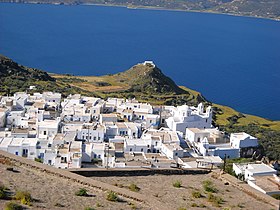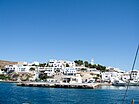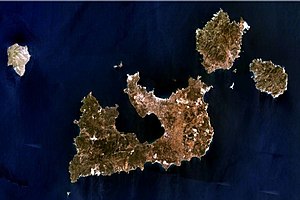Milos
Milos
Μήλος | |
|---|---|
| Coordinates:36°41′N24°25′E/ 36.683°N 24.417°E | |
| Country | Greece |
| Administrative region | South Aegean |
| Regional unit | Milos |
| Seat | Plaka |
| Area | |
| • Municipality | 150.6 km2(58.1 sq mi) |
| Highest elevation | 751 m (2,464 ft) |
| Lowest elevation | 0 m (0 ft) |
| Population (2021)[1] | |
| • Municipality | 5,302 |
| • Density | 35/km2(91/sq mi) |
| Time zone | UTC+2(EET) |
| • Summer (DST) | UTC+3(EEST) |
| Postal code | 848 00, 848 01 |
| Area code(s) | 2287 |
| Vehicle registration | EM |
| Website | www |
MilosorMelos(/ˈmiːlɒs,-loʊs/;Modern Greek:Μήλος,romanized:Mílos,IPA:[ˈmilos];Ancient Greek:Μῆλος,romanized:Mêlos) is a volcanicGreek islandin theAegean Sea,just north of theSea of Crete.Milos is the southwestern-most island in theCycladesgroup.
TheVenus de Milo(now in theLouvre), thePoseidon of Melos(now in theNAMA) and theAsclepius of Milos(now in theBritish Museum) were all found on the island,[2]as was an archaicApollonow inAthens.Milos is a popular tourist destination during the summer. Themunicipalityof Milos also includes the uninhabited offshore islands ofAntimilosandAkradies.The combined land area is 160.147 square kilometres (61.833 sq mi)[3]and at the 2021 census the population was 5,193 inhabitants.
History
[edit]
Obsidian(a glass-like volcanic rock) from Milos was a commodity as early as15,000years ago.[4]Natural glass from Milos was transported over long distances and used for razor-sharp "stone tools" well before farming began and later: "There is no early farming village in theNear Eastthat doesn't get obsidian ".[5]The mining of obsidian did not lead to the development of permanent habitation or manufacturing on the island. Instead, those in search of obsidian arrived by boat, beaching it in a suitable cove and cutting pieces of the volcanic glass from the quarries.[6]
The position of Milos, between mainland Greece andCrete,and its possession of obsidian, made it an important centre of earlyAegean civilisation.Milos lost its arms-making importance whenbronzebecame the preferred material for the manufacture of weapons.[7]
The Bronze Age
[edit]The first settlement atPhylakopi(GreekΦυλακωπή) arose in theBronze Age,flourishing as the extraction of obsidian was in the decline. The first settlers weretunafishermen.[6]Lying on the north-east coast, 1896 excavations by theBritish School at Athensand later in 1973 by the British archaeologistColin Renfrew,[8][9]revealed a town wall and aMinoan-inspired structure, dubbed the Pillar room, which contained fragments of vivid wall paintings. The famous fresco of the flying fish[10]was found in the ruins of the Pillar room and was executed with delicate colouring and graphic observation of nature in the graceful movement of a fish. Stylistic similarities to Minoanfrescoesare suggested, and it could perhaps have been the work of a Cretan artist.[11]Part of the site has been washed away by the sea.
The antiquities found at the site covered three major periods, from the EarlyCycladic periodto theMycenaean period.At the site much pottery was excavated, with several changing styles and influences over the site's long occupation. In the early occupation of the site, there are many similarities and imports from other Cycladic islands and the settlement was very small. During theMiddle Bronze Agehowever, the site expanded significantly and the expansion of Minoan Crete saw an influx of Minoan pottery into the Cyclades, particularly atAkrotirionThera,though much found its way to Phylakopi. The quantities found at the Cycladic sites have been taken to suggest a Minoan control over the region, though it could also be the consumptive nature of the islanders adopting Cretan fashions. There is more than just pottery at Phylakopi however, the eruption of the Thera volcano saw a reduction in Minoan presence in the Cyclades and it is at this time that Mycenaean involvement on the islands increases. At Phylakopi (and unknown in the rest of the Cyclades) amegaronstructure, which is typically associated with the Mycenaean palaces, such as those atTiryns,PylosandMycenaehas been discovered. This has been taken to suggest that the Mycenaeans conquered the settlement and installed a seat of power for a governor. The evidence is not clear, though again it could be a legacy of the islanders adopting foreign elements into their culture. Particularly unexpected was the discovery in the 1970s of a shrine at the site, which contained many examples ofAegeanfigurines, including the famous "Lady of Phylakopi". The shrine is unprecedented in the Bronze Age Cyclades and has provided a valuable insight into the beliefs and rituals of the inhabitants of Phylakopi. The site was eventually abandoned and was never reoccupied.
Dorian settlement
[edit]The first Dorian settlement on Melos was established no earlier than the 1st millennium BC.Doriansare the ethnic group to which theSpartansbelonged, but the Dorian settlers of Melos made themselves independent. They eventually established a city whose site lies on the eastern shore of the bay, just south-west of the present-day community ofTrypiti.
From the 6th century BC up to the siege of 416 BC, Melos issued its own coinage, struck according to theMilesianweight standard: the base coin was thestaterwhich weighed just over 14 grams.[13][14][15]Melos was the only island in the Aegean Sea to use this standard.[16]Most coins bore the image of an apple, which is a pun because the ancient Greek word for "apple" (mêlon) sounded similar to the name of the island.[17]The coins also often bore the name of its people: ΜΑΛΙΟΝ (Malion) or some abbreviation thereof.[18]
By the 6th century BC, the Melians had also learned to write, and they used an archaic variant of theancient Greek scriptthat exhibitedCretanandTheraicinfluences. It was discarded after the siege of 416 BC.[19]
| Α | Β | Γ | Δ | Ε | Ϝ | Ζ | Η | Η | Θ | Ι | Κ | Λ | Μ | Ν | Ξ | Ο | Π | Ϻ | Ϙ | Ρ | Σ | Τ | Υ | Φ | Χ | Ψ | Ω | |
|---|---|---|---|---|---|---|---|---|---|---|---|---|---|---|---|---|---|---|---|---|---|---|---|---|---|---|---|---|
| Laconia (Sparta) |
– | – | (φσ) | – | ||||||||||||||||||||||||
| Attica (Athens) |
– | (χσ) | – | (φσ) | – | |||||||||||||||||||||||
| Melos | – | (κϻ) | – | (πh) | (κh) | (πϻ) |


From at least as early as 470 BC and ending with the siege of 416 BC, the Melians exportedterracotta reliefs,which were typically use as door or chest ornaments and depicted scenes from mythology.
During thesecond Persian invasion of Greecein 480 BC, the Melians refused to submit toPersiaand contributed two warships to the Greek war effort, which were used at theBattle of Salamis.[20]After the battle, the Melians returned to their traditional isolationism.[21]
Siege of 416 BC
[edit]During thePeloponnesian War(431-404 BC) between Athens and Sparta, the Melians made some small donations to the Spartan war effort,[22][23]but remained largely neutral despite sharing the Spartans'Dorianethnicity. In 426 BC, the Athenians raided the Melian countryside, and the following year demanded tribute,[24]but Melos refused. In the summer of 416 BC, Athens invaded again with 3,400 men, and demanded that Melos ally with them against Sparta, or be destroyed. The Melians rejected this, so the Athenian army laid siege to the city and eventually captured it in the winter. After the city's fall, the Athenians executed all the adult men,[25]and sold the women and children into slavery. They then settled 500 of their own colonists on the island.[26]
In 405 BC, with Athens losing the war, the Spartan generalLysanderexpelled the Athenian settlers from Melos and repatriated the survivors of the siege.[27][28]Sparta annexed Melos, which would mean that like other liberated islands, it received a military governor (aharmost).[29]The cultural distinctiveness of Melos faded away as it was absorbed into mainstream Greek culture.[30]Their coinage switched to the Rhodian standard[31](tetradrachmsweighing 15.3 g[32]) and ceased bearing the word ΜΑΛΙΟΝ. The production of itsterracottareliefs also ceased.
The Hellenistic period
[edit]In 338 BC,Philip II of Macedondefeated the Greeks at theBattle of Chaeroneiaand became theoverlordof Greece and theCyclades.During this time, Melos and the nearby islandKimolosdisputed each other over the ownership of the islands ofPolyaigos,Heterea, and Libea (the last two are probably today's uninhabited islands ofAgios Efstathios and Agios Georgios). In the past, this dispute would have been settled by war, but the two communities took their dispute toArgoson the Greek mainland. TheArgivesdecided the islands belonged toKimolos.[33]
The Roman and Byzantine period
[edit]In 197 BC, theRomansforced Philip V to withdraw from Greece, and Melos subsequently came under Roman influence.
During the early 9th century CE theCycladeswere harassed byArabraiders, though how Milos fared at this time is unclear. Milos was mentioned in aByzantinechrysobullof 1198, which shows it was still important to the Byzantines.[34]
Medieval period
[edit]
In the aftermath of theFourth Crusade(1204), theVenetianMarco Sanudoseized control of Milos and a number of other islands in theCyclades.Sanudo declared himself theDuke of Naxos,after the island where he established his capital. Sanudo did not make his duchy a vassal of Venice, but instead declared loyalty to theLatin Emperor.[35]Sanudo's dynasty lasted nine generations, then was succeeded by theCrispos.Both families wereCatholic.The majority of the population was (and still is)Greek Orthodox.
Up to this point, the population of Melos was overwhelmingly Greek Orthodox Christian, just like the rest of the archipelago. When the Venetians conquered the archipelago, they brought Catholicism with them. The first Catholic bishop of Milos was appointed in 1253.[36]
Ottoman period
[edit]In 1566 the Venetians handed over the Duchy of Naxos to theOttoman Empire,and its last Catholic duke fled to Venice. The Ottoman sultanSelim IIappointed aPortuguese JewnamedJoseph Nasias its duke. Upon Nasi's death in 1579, the Ottomans formally annexed the territory.[37]

In the early 18th century, the population surpassed 6,000[38]and was almost entirely Greek and Christian. It was ruled by Turkish judge orkadi,and a Turkish governor orvoivode.Thevoivodewas responsible for collecting taxes and enforcing the decisions of thekadi.The day-to-day affairs of the island were managed by three elected magistrates (epitropi), although any of their decisions could be appealed to thekadi.The island had twobishops:one Greek Orthodox and one Latin Catholic. The Greek bishop was wealthier than his Latin counterpart, as he had a larger revenue base. Although the islanders enjoyed a great degree of autonomy, they chafed under the heavy taxation of their Ottoman overlords.[39][40]
In 1771 the island was occupied by theRussian Empirefor three years, then retaken by the Ottomans.
In the late 18th century, the population declined considerably for uncertain reasons.[41]By 1798, it had fallen below 500 people.[42]Visitors reported that up to two thirds of the buildings had fallen into ruin. It began growing again in the early 19th century, reaching 5,000 people by 1821.[43]Reliable figures are hard to find as the Ottoman Empire never performed acensusbefore 1881.
Modern period
[edit]
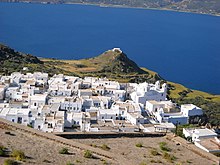
Milos was one of the first islands to join theGreek War of Independenceof 1821. The first naval battle of the war took place off the coast of Milos on 11 April 1821.[44]Milos became a refuge for refugees from numerous islands, particularly Crete. The port town ofAdamantaswas founded by Cretan refugees from theCretan Revolt in 1841.[45][46]
WhenTheodore Benttoured the island in December 1883, note-taking for his guide to the Cyclades, he found that “There is a lack of energy nowadays in Melos, forSyramonopolises all the trade that once came here, and the Cretan exiles refuse to cultivate as they ought the fertile centre of the island, for they are only awaiting a favourable turn in events to return to their own island…”[47]
During the 19th century, Milos was a major rendezvous point for American and British ships fighting Muslim pirates in the Mediterranean.[citation needed]
In February 1943, 14 male civilians wereexecutedfor collecting material owned by theGerman occupation forcesthat was washed up after the sinking of a cargo ship by Allied aircraft.[citation needed]
The population peaked in 1928 at 6,562 people.[48]In 2011 it was 4,977.
Geography
[edit]This sectionneeds additional citations forverification.(July 2020) |

Milos is the southwestern-most island in the Cyclades, 120 kilometres (75 miles) due east from thecoastof Laconia. From east to west it measures about 23 km (14 mi), from north to south 13 km (8.1 mi), and its area is estimated at 151 square kilometres (58 sq mi). The greater portion is rugged and hilly, culminating in Mount Profitis Elias 748 metres (2,454 feet) in the west. Like the rest of the cluster, the island is ofvolcanicorigin, withtuff,trachyteandobsidianamong its ordinary rocks. Volcanic activity began 2 to 3 million years ago during thePliocene,and last erupted 90,000 years ago during thePleistocene,and is considered to still be adormant volcanothat could erupt again. The naturalharbouris the hollow of the principal crater, which, with a depth diminishing from 70 to 30fathoms(130–55 m), strikes in from the northwest so as to separate the island into two fairly equal portions (see photo), with an isthmus not more than 18 km (11 mi) broad. In one of the caves on the south coast, the heat from the volcano is still great, and on the eastern shore of the harbour, there are hotsulfuroussprings.[49][50][51]
Antimelos or Antimilos, 13 miles (21 km) north-west of Milos, is an uninhabited mass of trachyte, often called Erimomilos (Desert Milos). Kimolos, or Argentiera, 1.6 km (0.99 mi) to the north-east, was famous in antiquity for itsfigsandfuller's earth,and contained a considerable city, the remains of which cover the cliff of St. Andrew's.Polyaigos(also called Polinos, Polybos or Polivo — alternative spelling Polyaegos) lies 2 km (1 mi) south-east of Kimolos. It was the subject of dispute between the Milians and Kimolians. It is now uninhabited.
The harbour town is Adamantas; from this there is an ascent to the plateau above the harbour, on which are situatedPlaka,the chief town, andKastro,rising on a hill above it, and other villages. The ancient town of Milos was nearer to the entrance of the harbour than Adamas, and occupied the slope between the village ofTrypitiand the landing-place atKlima.Here is a theatre ofRomandate and some remains of town walls and other buildings, one with a finemosaicexcavated by theBritishschool at Athens in 1896. Numerous fine works of art have been found on this site, notably theAphroditeinParis,theAsclepiusinLondon,and thePoseidonand the archaicApolloin Athens. Other villages includeTriovasalos,Peran Triovasalos,PolloniaandZefyria(Kampos).
Climate
[edit]Milos has aMediterranean climate(Köppen climate classification:Csa) with mild, rainy winters and warm to hot dry summers.[52]
| Climate data for Milos | |||||||||||||
|---|---|---|---|---|---|---|---|---|---|---|---|---|---|
| Month | Jan | Feb | Mar | Apr | May | Jun | Jul | Aug | Sep | Oct | Nov | Dec | Year |
| Record high °C (°F) | 21.6 (70.9) |
26.2 (79.2) |
25.6 (78.1) |
28.4 (83.1) |
35.4 (95.7) |
44.0 (111.2) |
41.0 (105.8) |
39.8 (103.6) |
36.3 (97.3) |
32.0 (89.6) |
27.8 (82.0) |
23.4 (74.1) |
44.0 (111.2) |
| Mean daily maximum °C (°F) | 12.9 (55.2) |
13.2 (55.8) |
14.8 (58.6) |
18.4 (65.1) |
22.8 (73.0) |
27.1 (80.8) |
28.1 (82.6) |
27.6 (81.7) |
25.2 (77.4) |
21.3 (70.3) |
18.0 (64.4) |
14.6 (58.3) |
20.3 (68.5) |
| Daily mean °C (°F) | 10.5 (50.9) |
10.7 (51.3) |
12.1 (53.8) |
15.2 (59.4) |
19.3 (66.7) |
23.5 (74.3) |
25.0 (77.0) |
24.6 (76.3) |
22.3 (72.1) |
18.5 (65.3) |
15.3 (59.5) |
12.3 (54.1) |
17.4 (63.3) |
| Mean daily minimum °C (°F) | 8.5 (47.3) |
8.5 (47.3) |
9.6 (49.3) |
12.4 (54.3) |
15.9 (60.6) |
19.8 (67.6) |
21.8 (71.2) |
21.6 (70.9) |
19.6 (67.3) |
16.1 (61.0) |
13.1 (55.6) |
10.3 (50.5) |
14.8 (58.6) |
| Record low °C (°F) | −2.0 (28.4) |
−2.0 (28.4) |
0.0 (32.0) |
5.4 (41.7) |
8.0 (46.4) |
10.0 (50.0) |
14.0 (57.2) |
14.2 (57.6) |
11.6 (52.9) |
8.0 (46.4) |
2.8 (37.0) |
0.0 (32.0) |
−2.0 (28.4) |
| Averageprecipitationmm (inches) | 74.7 (2.94) |
50.6 (1.99) |
47.2 (1.86) |
20.5 (0.81) |
13.1 (0.52) |
3.3 (0.13) |
0.3 (0.01) |
1.4 (0.06) |
5.8 (0.23) |
42.9 (1.69) |
60.7 (2.39) |
90.3 (3.56) |
410.8 (16.17) |
| Average precipitation days(≥ 1.0 mm) | 8.8 | 7.3 | 5.7 | 2.9 | 1.4 | 0.3 | 0.1 | 0.1 | 0.9 | 3.9 | 5.8 | 9.0 | 46.2 |
| Averagerelative humidity(%) | 73.3 | 72.5 | 72.0 | 67.0 | 63.5 | 58.8 | 60.1 | 63.4 | 66.8 | 71.3 | 73.9 | 73.7 | 68.0 |
| Source: NOAA[53] | |||||||||||||
Natural resources
[edit]Volcanic minerals
[edit]
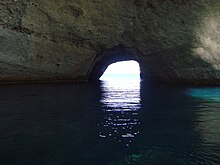
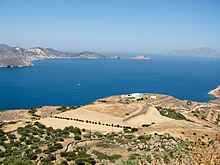
Bentonite,perlite,pozzolanaand small quantities ofkaolinare actively collected viastrip mineoropen-pit minetechniques in Milos and sold all over the world. In the past,baryte,sulfur,millstones andgypsumwere also mined;Pliny the Eldernotes that Milos was the most abundant source of sulfur in the ancient world.[54]In ancient times thealumof Milos was reckoned next to that ofEgypt(Pliny xxxv. 15 [52]). The Melian earth was employed as apigmentby ancient artists. Milos was a source ofobsidianduring the Neolithic ages for the Aegean and Mediterranean.
Agricultural crops
[edit]Orange,olive,cypress,tamarisk, juniper (Juniperus oxycedrus) andarbutustrees grow throughout the island, which, however, is too dry to have any profusion of vegetation.Vines,cotton,andbarleyare the main crops.
Medicinal plants
[edit]Almost all of the uninhabited western region of Milos is aNatura 2000site and is home to over 800 differenttaxa,including 35 which areendemicto Greece. In anethnobotanical surveyof Milos, numerous native and cultivated species were described as being used to treat a variety of conditions and for other purposes such asinsect repellents,disinfectants, and to protect against theevil eye.[55]The most frequently reported species wasGreek sage.Local historical records of medicinal plant use date back to the 16th century.
Sister island
[edit] Shōdoshima,Kagawa,Japan(1989)
Shōdoshima,Kagawa,Japan(1989)

Demographics
[edit]Historical population
[edit]| Year | Island population |
|---|---|
| 1798 | 500[42] |
| 1812 | 2,300[56] |
| 1821 | 5,000[43] |
| 1907 | 5,393[57] |
| 1928 | 6,562 |
| 1991 | 4,380 |
| 2001 | 4,771 |
| 2011 | 4,977 |
Modern popularity
[edit]While a lesser-known island within the extremely popularCycladesarchipelago,Milos has grown in popularity as a vacation destination in the past several decades. With its traditional Greek architecture, slower pace compared toSantoriniandMykonos,and varied beaches.[58]
Popular culture
[edit]- The 2007 filmTo Fili Tis Zoiswas shot in Milos and specifically inPlakaand the port ofAdamas.The name of the island is also referred to during the movie.[59]
People
[edit]- Antonio Millo(active 1557–1590), captain and cartographer
- Antonio Vassilacchi(1556–1629), painter
- Diagoras(5th century BC),philosopher
- Melanippides(5th century BC), poet
See also
[edit]References
[edit]- ^"Αποτελέσματα Απογραφής Πληθυσμού - Κατοικιών 2021, Μόνιμος Πληθυσμός κατά οικισμό"[Results of the 2021 Population - Housing Census, Permanent population by settlement] (in Greek). Hellenic Statistical Authority. 29 March 2024.
- ^"statue".British Museum.Retrieved25 March2019.
- ^"Population & housing census 2001 (incl. area and average elevation)"(PDF)(in Greek). National Statistical Service of Greece. Archived fromthe original(PDF)on 2015-09-21.
- ^N. Laskaris, A. Sampson, F. Mavridis, I. Liritzis, (September 2011) "Late Pleistocene/Early Holocene seafaring in the Aegean: new obsidian hydration dates with the SIMS-SS method" Journal of Archaeological Science, Volume 38, Issue 9, pp.2475–2479
- ^C. Renferew
- ^abDavid Abulafia(2011).The Great Sea: A Human History of the Mediterranean.Penguin Books.ISBN978-0-14-196999-2.
- ^Chalk and Jonassohn, 65
- ^"Renfrew, Colin".Retrieved2023-09-13.
- ^"Archaeological Site of Phylakopi".Retrieved2023-09-13.
- ^Flying fishArchived2015-10-22 at theWayback Machine
- ^CAH pg. 448
- ^Based on a map by Brian Sparkes, published inRenfrew & Wagstaff (1982).
- ^Brain Sparkes, inRenfrew & Wagstaff (1982),p 230: "Melian coins of the late sixth and fifth centuries are of silver [...] and based on the Milesian weight standard."
- ^Gardner (1918):"Already, in the sixth century, Melos struck coins on a different standard from that of most of the other islands of the Aegean, the stater weighing about 224 grains (grm. 14.50). Certain coins of the Santorin find (p. 122) are not of Aeginetan but of this Phoenician weight."
- ^According to the website of Robert J. O'Hara (http://rjohara.net/coins/history/), a Lydo-Milesianstaterweighed 14.10 grams.
- ^Brain Sparkes, inRenfrew & Wagstaff (1982),p 47
- ^Hill (1899),p. 176
- ^Brain Sparkes, inRenfrew & Wagstaff (1982),p 230
- ^Brain Sparkes, inRenfrew & Wagstaff (1982)
- ^Herodotus.The Histories,46-48: "TheSeriphians,Siphnians,and Melians also took part, since they were the only islanders who had not given earth and water to the barbarian. [...] All of these came to the war providingtriremes,except the Melians and Siphnians and Seriphians, who brought fifty-oared boats. The Melians (who are ofLacedaemonianstock) provided two; the Siphnians and Seriphians, who areIoniansfromAthens,one each. The total number of ships, besides the fifty-oared boats, was three hundred and seventy-eight. "
- ^Brain Sparkes, inRenfrew & Wagstaff (1982),p 49
- ^Geoffrey Ernest Maurice de Ste Croix (1954). "The Character of the Athenian Empire". An essay originally published inHistoria3, republished inLow (2008),pp. 245–246: "Epigraphic evidence allows us to go further still: it puts the original Athenian attack on Melos in quite a different light. The inscription found near Sparta [...] records two separate donations by Melos to the Spartan war-funds, one of twenty Aeginetan minae [...] The other figure has perished. The donors are described, it will be noticed, astoi Malioi,'the Melians'. [...] This shows that the Melian subscription was an official one. [...] there is good reason to think these gifts to Sparta were made in the spring of 427. "
- ^The evidence is an inscription (IG V 1, 1) which reads: "The Melians gave to the Lacedaimonians twenty mnas of silver." SeeLoomis (1992),p 13
- ^Brian Sparkes, inRenfrew & Wagstaff (1982),p. 49
- ^Thucydides.History of the Peloponnesian War,116
The key word in the account by Thucydides ishebôntas(ἡβῶντας), which generally describes people who have passed puberty and in this context refers to the men as Thucydides described a different fate for the women and children. Some translators such as Rex Warner translated this as "men of military age". Another possible translation is "men in their prime". Thucydides made no specific mention of what happened to the elderly males. - ^Thucydides.History of the Peloponnesian War,5.84-116
- ^Xenophon.Hellenica,2.2.9:"Meantime Lysander, upon reaching Aegina, restored the state to the Aeginetans, gathering together as many of them as he could, and he did the same thing for the Melians also and for all the others who had been deprived of their native states."
- ^Plutarch.Life of Lysander,14.3:"But there were other measures of Lysander upon which all the Greeks looked with pleasure, when, for instance, the Aeginetans, after a long time, received back their own city, and when the Melians and Scionaeans were restored to their homes by him, after the Athenians had been driven out and had delivered back the cities."
- ^Brian Sparkes, inRenfrew & Wagstaff (1982),p. 49-50: "Melos thus passed from Athenian to Spartan control, and the Melians who returned found a government of ten established, made effective by the presence of a Spartan garrison and of aharmostor military commander. "
- ^Brian Sparkes, inRenfrew & Wagstaff (1982)
- ^Brian Sparkes, inRenfrew & Wagstaff (1982),p 231
- ^O'Hara, Robert James (1959-)."History, Metals, and Weight Standards (Ancient Coins of Miletos)".rjohara.net.Retrieved25 March2019.
{{cite web}}:CS1 maint: numeric names: authors list (link) - ^Brain Sparkes, inRenfrew & Wagstaff (1982),p 50
- ^Renfrew & Wagstaff (1982),p. 58
- ^Renfrew & Wagstaff (1982),p. 58-69
- ^"Diocese of Milos, Greece".GCatholic.Retrieved25 March2019.
- ^"History of Milos island - Greeka".Greeka.Retrieved25 March2019.
- ^Renfrew & Wagstaff (1982)
- ^Tournefort (1717),p. 180-181
- ^Thompson (1752),vol 1, p. 291-300
- ^Renfrew & Wagstaff (1982),p. 69
- ^abOlivier (1801),p. 156
- ^abRenfrew & Wagstaff (1982),p. 148
- ^"History of Milos island | Greeka".Greekacom.Retrieved2022-06-24.
- ^"Milos".greece.org.Retrieved2022-06-24.
- ^Heikell, Rod (2020-01-01).West Aegean.Imray, Laurie, Norie and Wilson Ltd. p. 212.ISBN978-1-78679-089-7.
- ^Theodore Bent,The Cyclades, or Life Among the Insular Greeks(London, 1885, pp. 57ff.).
- ^Renfrew & Wagstaff (1982),p. 70
- ^"Milos Island: Working with Earth for 9000 years".
- ^"Archived copy".Archived fromthe originalon 2012-07-22.Retrieved2020-07-30.
{{cite web}}:CS1 maint: archived copy as title (link) - ^"Volcanoes in Greece & Greek islands | Greeka".
- ^Kottek, M.; J. Grieser; C. Beck; B. Rudolf; F. Rubel (2006)."World Map of the Köppen-Geiger climate classification updated"(PDF).Meteorol. Z.15(3): 259–263.Bibcode:2006MetZe..15..259K.doi:10.1127/0941-2948/2006/0130.RetrievedJanuary 29,2013.
- ^"Milos Climate Normals 1961-1990".National Oceanic and Atmospheric Administration.RetrievedJanuary 29,2013.
- ^C. Michael Hogan (2011).Sulfur.Encyclopedia of Earth, eds. A. Jorgensen and C.J. Cleveland, National Council for Science and the environment, Washington DCArchived2012-10-28 at theWayback Machine
- ^Perouli, Mary; Bareka, Pepy (2022-04-26)."Ethnobotanical survey on medicinal plants from Milos island (Kiklades Islands, Greece)".Mediterranean Botany.43:e75357.doi:10.5209/mbot.75357.ISSN2603-9109.
- ^Turner (1820),p. 32
- ^1907 Greek census (1909), statistics.gr, page 411 (Δήμος Μήλου/ Milos Municipality 4.864 + Δήμος Αδάμαντος / Adamas Municipality 529 = 5.393)
- ^Dardanis, Amanda (2019-03-28)."Marvellous Milos: the Greek island full of fresh flavours".The Guardian.ISSN0261-3077.Retrieved2020-02-05.
- ^Archived atGhostarchive
Sources
[edit]- This article incorporates text from a publication now in thepublic domain:Chisholm, Hugh,ed. (1911). "Melos".Encyclopædia Britannica(11th ed.). Cambridge University Press.
- I.F. Stone,1988, The trial of Socrates, Anthos.
- Cambridge Ancient History, Vol.II, 1924, New York, MacMillan
- Colin Renfrewand Malcolm Wagstaff (editors), 1982, An Island Polity, the Archaeology of Exploitation in Melos, Cambridge, Cambridge University Press.
- Colin Renfrew(editor), 1985, The Archaeology of Cult, the Sanctuary atPhylakopi,London, British School at Athens and Thames & Hudson.
- Leycester, "The Volcanic Group of Milo, Anti-Milo, &c.," inJour. Roy. Geog. Soc.(1852).
- Tournefort,Voyage.
- William Martin Leake,Northern Greece,iii.
- Anton von Prokesch-Osten,Denkwürdigkeiten,&c.
- Bursian,Geog. von Griechenland,ii.;Journ. Hell. Stud,xvi, xvii, xviii,Excavations at Phylakopi;Inscr. grace,xii. iii. 197 sqq.;
- on coins found in 1909, see Jameson inRev. Num.1909; 188 sqq.
- "Mílos".Global Volcanism Program.Smithsonian Institution.Retrieved2009-01-01.
- Seaman, Michael G.,"The Athenian Expedition to Melos in 416 B.C.,"Historia46 (1997) pp. 385–418.
- Chalk, Frank; Jonassohn, Kurt (1990).History and Sociology of Genocide: Analyses and Case Studies.New Haven:Yale University Press.pp.65–66.ISBN0-300-04445-3.
- Bosworth, A.B. (2005).""Athens and Melos." Genocide and Crimes Against Humanity ed. Dinah L. Shelton ".Gale Cengage, enotes. Archived fromthe originalon October 5, 2009.Retrieved26 September2009.
- Connor, W. Raymond (1984).Thucydides.Princeton:Princeton University Press.p. 151.
- Thucydides(1954).The Peloponnesian War.Harmondsworth: Penguin Books.
- Hill, G. F. (1899).A Handbook of Greek and Roman Coins.Macmillan and Co., Limited.
- Loomis, William T. (1992).The Spartan War Fund: IG V 1, 1 and a New Fragment.Franz Steiner Verlag.ISBN978-3-515-06147-6.
- Renfrew, Colin; Wagstaff, Malcolm, eds. (1982).An Island Polity: The Archaeology of Exploitation in Melos.Cambridge University Press.ISBN0-521-23785-8.
- Thucydides (c. 400 BC).History of the Peloponnesian War.Translated by Richard Crawley (1914).
- David Abulafia(2011).The Great Sea: A Human History of the Mediterranean.Penguin Books.ISBN978-0-14-196999-2.
- Tournefort, Joseph Pitton de (1717).Relation d'un Voyage du Levant[An Account of a Voyage into the Levant] (in French).
- Thompson, Charles (1752).The Travels of the Late Charles Thompson, Esq.Vol. 1. Reading, Newberry.
- Turner, William (1820).Journal of a Tour in the Levant, Vol. 1.John Murray, Albemarle-Street.
- Olivier, Guillaume Antoine (1801).Travels in the Ottoman Empire, Egypt, and Persia.Paris H. Agasse.
- Gardner, Percy (1918).A History of Ancient Coinage.Oxford at the Clarendon Press.
- Low, P. (2008).Athenian Empire.Edinburgh Readings on the Ancient World. Edinburgh University Press.ISBN978-0-7486-3124-7.Retrieved2020-06-04.
External links
[edit]- Official website(in English and Greek)
- Milos
- Cyclades
- Islands of Greece
- Islands of the South Aegean
- Landforms of Milos (regional unit)
- Members of the Delian League
- Municipalities of the South Aegean
- Populated places in Milos (regional unit)
- Subduction volcanoes
- Submarine calderas
- Volcanoes of Greece
- Volcanoes of the Aegean
- Stratovolcanoes
- Pliocene volcanoes
- Pleistocene stratovolcanoes
- Dormant volcanoes
- Populated places in the ancient Aegean islands

